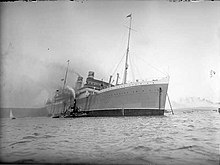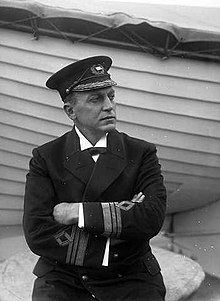Bergensfjord (ship, 1913)
|
||||||||||||||||||||||||
|
||||||||||||||||||||||||
|
||||||||||||||||||||||||
|
||||||||||||||||||||||||
The Bergensfjord (I) was a passenger ship of the Norwegian shipping company Den norske Amerikalinje that was put into service in 1913 and operated as a transatlantic liner between Norway and the USA . During the Second World War she was under the British Ministry of War Transport (MoWT) and served as an Allied troop transport . After the war, the Bergensfjord was used again as an ocean liner by various owners and renamed several times until it was sold to Italy for demolition in 1959 .
Beginnings
The Bergensfjord and her identical sister ship Kristianiafjord were the first ships of the Norwegian shipping company Den norske Amerikalinje A / S (NAL), founded in 1910 and known in the English-speaking world as Norwegian-America Line . Both ships were designed as passenger and cargo ships and built by the shipyard Cammell, Laird & Company in the English port city of Birkenhead . The Kristianiafjord (construction number 784) was launched on November 23, 1912 and the Bergensfjord (construction number 787) on April 8, 1913.
The 10,699 GRT steel-built Bergensfjord was 155.99 meters long, 18.65 meters wide and had a maximum draft of 11.46 meters. It was powered by two eight-cylinder, quadruple expansion steam engines, also manufactured by Cammell, Laird and Company, with an output of 1,469 hp . The ship had two propellers , two masts and two funnels. The top speed was 15 knots. The coal was burned in eight single-end steam boilers with a total of 32 furnaces. In Hulk eight were Scot installed. The ship was equipped with electric lights, wireless radio and a double floor.
In the Bergensfjord's passenger accommodation there was space for 1200 travelers, 100 of them in first, 250 in second and 850 in third class. On September 25, 1913, the Bergensfjord set sail under the command of Captain Kjeld Stub Irgens in Oslo on her maiden voyage via Kristiansand , Stavanger and Bergen to New York . This was the usual route for their shipping company. The fact that the NAL ships went directly from Norway to New York without going to continental European ports was new and saved a lot of time. This method cut travel time from up to four weeks to one week. The shipping company's early ships, such as the Bergensfjord , the Kristianiafjord and the Stavangerfjord , which entered service in 1918, offered passengers considerably more comfort than before. This factor made the NAL very successful and made it into competition with Det Forenede Dampskibs-Selskab , another thriving Scandinavian shipping company.

In July 1924, shortly after leaving Bergen, there was an explosion in the ship's engine room and a subsequent fire. The crew let the Bergensfjord run aground. In September 1924 she was back in passenger traffic after repairs. In the following years there were several restructuring of passenger capacities. From November 1925, the Bergensfjord could carry 367 first class passengers and 572 third class passengers. From September 1927 there were 90 passengers in the first, 155 in the second and 500 in the third class. In 1933, the tonnage of the ship increased to 11,015 GRT through modifications. From January 1939 she could only take first and third class passengers; the second class was abolished.
Second World War
On April 7, 1940, two days before the German occupation of Norway , the Bergensfjord left Bergen for her last civilian voyage under the Norwegian flag to New York. After arriving in New York on April 15, it was initially launched. In November 1940 she was requisitioned as a troop transport by the British Ministry of War Transport (MoWT) and converted accordingly in Liverpool in the following months .
In February 1941 the Bergensfjord left Liverpool for its first troop voyage via Glasgow and Freetown to Durban (South Africa). In 1942 she took part as a transport ship in Operation Torch in North Africa and in 1943 in Operation Husky in Sicily . During Operation Husky, the Bergensfjord took in the survivors of the British hospital ship Talamba , which was bombed and sunk by German fighter bombers.
By the end of the war, the Bergensfjord had covered 300,000 miles, transported 165,000 Allied troops and spent 919 days at sea. She had also prisoners of war of the Axis powers transports and returned liberated Allied prisoners of war in their homeland. In February 1946, the Bergensfjord was used for a trip to bring so-called War Brides ("war brides") to the United States. During a crossing from Europe to Jamaica , during which 200 civilians and 1,400 dark-skinned soldiers were on board, a mutiny broke out among the soldiers , which it was difficult to stop. The warship HMS Ballinderry was sent to aid the Bergensfjord . Upon the arrival of the ship, the soldiers were interned in Kingston . The Bergensfjord was then returned to the NAL.

post war period
In August 1946 the Bergensfjord was sold to the Panamanian shipping company Panamanian Lines Inc. and renamed Argentina . From then on, the steamer was used for emigrant trips from Europe to South America . On January 13, 1947, the Argentina first sailed in Genoa (Italy). After renovations in 1949, the ship was able to carry 126 passengers in the first class, 250 in the second class and 574 in the third class. From September 1947 the Argentina sailed from Genoa to Central America and in 1951 crossings from Genoa to North American ports began.
In 1952 the ship was sold to the Italian shipping company Home Lines , founded in 1946 , which in turn sold it to the Israeli shipping company Zim Israel Navigation Co. Ltd. in 1953. sold, which she renamed Jerusalem . As Jerusalem , it drove from Israel to New York and was able to transport 38 first class passengers and 741 third class passengers. She also made eleven crossings from Haifa to North America .
In 1957 it was placed on the Israel – Marseille route and renamed Aliya . In 1959, the 46-year-old ship was sold to Italy for demolition and arrived in La Spezia on August 13, 1959 , where it was scrapped shortly afterwards.

